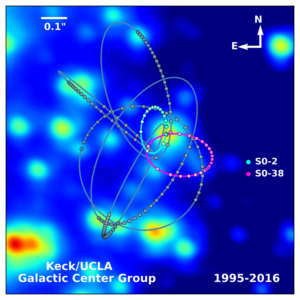Hilo High School Graduate Leads Important Astronomy Study

Devin Chu of Hilo, Hawai‘i is an astronomy graduate student at UCLA. The Hilo High School and 2014 Dartmouth College alumnus conducts his research with the UCLA Galactic Center Group, which uses the W. M. Keck Observatory on Hawai‘i Island to obtain scientific data. CREDIT: D. CHU.
A Hilo High School alumnus led a recent study that will pave the way for groundbreaking research on the nature of gravity and Einstein’s Theory of General Relativity.
David Chu of Hilo, an astronomy graduate student at UCLA, was the lead author of a paper investigating S0-2, a mysterious star situated near the center of our Milky Way galaxy. The study, which utilized data gathered at W.M. Keck Observatory on Maunakea, found that S0-2 is in fact a single star—not a binary system where two stars orbit one another—and debunks previous thinking.
As a result, S0-2 will be the focus of the first study to measure gravitational effects on a star by a black hole, ultimately testing the realm of gravity in Einstein’s theory. Gravity is the least-understood force among the five known forces in the universe.
“This is the first study to investigate S0-2 as a spectroscopic binary,” said Chu, who works within UCLA’s Galactic Center Group. “It’s incredibly rewarding. This study gives us confidence that a S0-2 binary system will not significantly affect our ability to measure gravitational redshift.”
The study results were published in The Astrophysical Journal.

The orbit of S0-2 (light blue) located near the Milky Way’s supermassive black hole will be used to test Einstein’s Theory of General Relativity and generate potentially new gravitational models.
CREDIT: S. SAKAI/A.GHEZ/W. M. KECK OBSERVATORY/ UCLA GALACTIC CENTER GROUP.
Einstein’s Theory of General Relativity proposes that light coming from a strong gravitational field gets stretched or “redshifted.” Researchers expect to measure this phenomenon for the first time beginning in the spring as S0-2 makes its closest approach to the supermassive black hole at the center of our galaxy. Chu and the team of UCLA researchers will return to Keck Observatory this spring to begin observations for the Einstein test.
“It will be the first measurement of its kind,” said co-author Tuan Do, deputy director of the Galactic Center Group. “Gravity is the least well-tested of the forces of nature. Einstein’s theory has passed all other tests with flying colors so far, so if there are deviations measured, it would certainly raise lots of questions about the nature of gravity!”
“We have been waiting 16 years for this,” said Chu. “We are anxious to see how the star will behave under the black hole’s violent pull. Will S0-2 follow Einstein’s theory or will the star defy our current laws of physics? We will soon find out!”
















